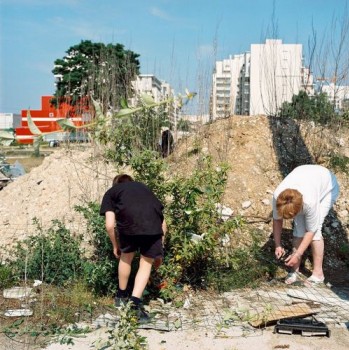Cyrille Weiner

© Cyrille Weiner
The photographer is interested in the dependency relations between collective and individual spheres in urban sur- roundings. Town-planning necessarily structures our uses of cities by organising the circulation of bodies and glances on a global scale. This reading grid of a territory tends to act as a proxy for the personal opinion of users. It conditions their way of appreciating and experiencing the environment.
In order to examine this phenomenon from the outside, Cyrille Weiner distances himself from the strictly documentary aspect of photography. He relies on the revealing powers of paradigmatic fictions like those of catastrophe or paradise lost. These scenarii allow him to build allegories that tackle a universal question, that of our relationship to the world. For the photographer, it is not about thinking against town-planning; it is about looking for a radical, or even utopian exteriority in it, from which a criticism of its normed space becomes possible.
To leave a normed space is to escape its authorised reading grid. On the outskirts of cities, Cyrille Weiner explores pla- ces where the urban fabric has been stopped. He observes the signs of human presence, paying attention to the way it manifests itself where you don’t expect it. When he is away on long sessions to check out places, he accumulates atmos- pheres, traces of human activity, and atmospheric variations of light. He then uses them to make his story board more precise. Once the setting for his photographs is chosen, the photographer does not move around any more. He anticipa- tes the movement within the setting, and composes in real time with the parameters of the territory. This method, both precise and open to possibilities, allows the photographer to intensify the tensions and the hints of harmony that come from a place occupied by individuals. What emerges from his work are ambiguous images, hung somewhere between the fading and the resurgence of an order.
The photographs he takes in a peripheral area of Nanterre contribute to this ambivalence. They describe a dying world, and at the same time, the vitality that emerges from these places with changing shapes. It is the same with the series Presqu’île and Bout du Monde, where holidaymakers and makehsift campers make the seaside look like a carefree and changing playground. The doings observed by the photographer in those territories which have not undergone any reifi- cation by collective infrastructures, can be read like kinesthetic experiences of the world. The impromptu nature of these activities avoid the standardisation of behaviours and happiness, and the planning of leisure.
Cyrille Weiner’s photographs bring the ideal of mastering normed spaces face to face, with the free interpretation of a territory by individuals. Intensified with powerful images, this confrontation of scales questions the influence of col- lective planning on the spatial and temporal structuring of our lives, and on an unconscious scale, on our aspirations and desires. The exhibition arrangements designed by Cyrille Weiner symbolically play again this breakaway of gazes outside the usual formats of exhibitions. At the Villa Noailles, his photographs were inserted between fake bricks that structured the space. In the Lectoure photographic centre, visitors would leave the building to discover an publication of photographic journals displayed in a dovecote turned into a reading closet. They are some of the many ways in which visitors are diverted from usual froms of receiving of works of art, in order to shake them out of their habits, and create a poetic experience of places and gazes.
Marguerite Pilven, February 2011


